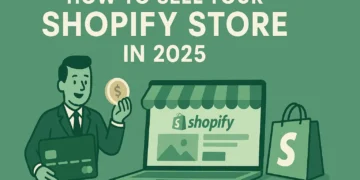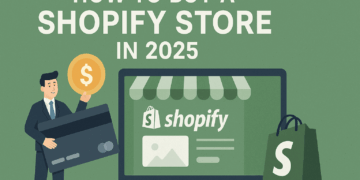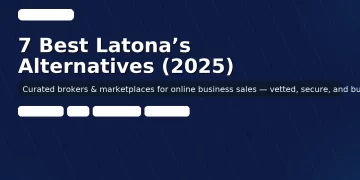If you’re thinking about selling your blog, you’re likely at a pivotal moment, balancing the idea of cashing in on your hard work with the ongoing effort of maintaining and growing your online business. Selling a blog can be a profitable option, especially if you’ve cultivated a site that is both established and lucrative. Whether you’re aiming to fund a new venture, address financial needs, or explore fresh opportunities, understanding the process is key to maximizing your profit and ensuring a seamless transition.
Your blog, which may have begun as a passion project or side hustle, has grown into a valuable asset. It likely generates income through channels like affiliate marketing, advertising, and selling digital products.
However, selling your blog is about more than just money—it requires timing and strategy. This guide will walk you through the steps, from preparing your site for sale to negotiating with buyers and completing the sale process.
Preparing Your Blog for Sale

Evaluating Your Blog’s Financial Performance
Evaluating the financial performance of your blog is a critical step in preparing it for sale. This process involves analyzing various financial metrics to understand the blog’s profitability, liquidity, and overall financial health. Here are some key financial performance indicators (KPIs) you should focus on:
Start by calculating your blog’s gross and net profit margins. The gross profit margin shows the percentage of revenue left after subtracting the cost of goods sold or, in the case of a blog, the costs associated with content creation and maintenance.
The net profit margin, on the other hand, indicates the profitability of your blog after all expenses, including operating costs, taxes, and any other deductions, have been accounted for.
Additionally, assess your blog’s liquidity by examining metrics such as the current ratio and quick ratio. These ratios help determine whether your blog has sufficient current assets to cover its short-term liabilities.
This is particularly important if your blog relies on consistent cash flow from advertising, affiliate marketing, or the sale of digital products.
Operational efficiency is another important aspect. Analyze metrics like the average monthly net profit, the number of months or years the blog has been generating consistent income, and the efficiency of your content creation and marketing processes. These metrics will help potential buyers understand the blog’s stability and growth potential.
Improving Your Blog’s Appeal
To make your blog more attractive to potential buyers, you need to improve its overall appeal. This involves several strategic steps:
First, ensure your blog has high-quality, engaging content that attracts and retains a loyal audience. Update your blog posts regularly to maintain relevance and keep your readers engaged.
Consider investing in SEO optimization to improve your blog’s search engine rankings, which can significantly increase its value.
Build a strong social media presence by integrating your blog with social media accounts. This helps to expand your reach and demonstrates to potential buyers that your blog is well-connected and has a broader audience beyond the website itself.
Develop an email list and engage with your subscribers regularly. An established email list is a valuable asset that can help drive traffic and generate income, making your blog more appealing to buyers.
Depersonalizing Your Blog
Depersonalizing your blog is essential to make it easier for a new owner to take over. Here are some steps to consider:
Avoid using personal anecdotes or branding that is too closely tied to your personal identity. Instead, focus on creating a brand that is independent of your personal presence.
This makes the transition smoother for the new owner and helps maintain the blog’s integrity and audience trust.
Document all processes and systems related to the blog, including content creation, marketing strategies, and financial management. This documentation will serve as a guide for the new owner, ensuring they can continue to run the blog efficiently without significant disruption.
Transfer ownership of social media accounts and other associated assets to the blog’s brand rather than your personal name. This ensures that the new owner can seamlessly take over all aspects of the blog’s online presence.
Get the best price for your business — we take care of the rest.
Start Selling for FreeValuing Your Blog

Understanding Blog Valuation Metrics
Valuing your blog accurately is important for attracting the right buyers and ensuring you get a fair price. Here are some key metrics and methods to understand when valuing your blog:
The most common method for valuing a blog involves calculating the Seller’s Discretionary Earnings (SDE) and applying a multiple to it. SDE represents the total profit your blog generates, excluding discretionary expenses that the new owner may not incur.
This metric is essential because it reflects the actual cash flow that the buyer can expect from the blog.
The multiple used in this calculation can vary widely, typically ranging from 20x to 80x, depending on factors such as the blog’s growth potential, risk level, transferability of ownership, and documentation. For instance, a blog with strong growth prospects, diversified revenue streams, and low risk might command a higher multiple, resulting in a higher valuation.
Revenue and profitability are also pivotal factors. Blogs with stable or increasing revenue streams are generally valued at a multiple of their monthly or annual earnings.
For example, a blog earning $1,000 monthly could be valued at 24 to 36 times its earnings, depending on the niche and traffic quality.
Traffic and engagement metrics are equally important. A blog with robust, steady traffic and high engagement (measured by metrics like bounce rate, time on site, and page views per session) is more valuable because it indicates a consistent and appreciative audience.
The niche and monetization potential of your blog also play a significant role. Blogs in profitable niches like finance, health, and technology tend to be more valuable due to their higher monetization prospects through affiliate marketing, sponsored content, and ad earnings.
Content quality and SEO performance are additional key factors. High-quality, timeless content that performs well in search engine rankings enhances the blog’s value.
Metrics such as keyword standings, backlink portfolio, and domain authority are important in this regard.
Tools and Resources for Valuation
To help you determine the value of your blog accurately, there are several tools and resources available:
Flippa offers a free online valuation tool that can provide you with a valuation range for your blog. This tool requires you to input details such as your blog’s URL, revenue and expenses for the last 12 months, website traffic, and niche information.
Flippa then uses this data to estimate your blog’s value and can even help you create a listing for sale.
Comparable sales are another useful method. Researching recent sales of blogs in your niche can give you a benchmark for what similar blogs are worth.
This approach helps you understand the market value of your blog by comparing it to others that have been sold.
Professional business advisors can also be invaluable, especially if your blog is worth over $100,000. They can provide a detailed valuation and help you navigate the complexities of the sale process, ensuring you get the best possible price for your blog.
Additionally, using financial tools and analytics platforms like Google Analytics, SEMrush, or Ahrefs can help you gather detailed metrics on your blog’s performance. These tools provide insights into traffic, SEO performance, and other key indicators that potential buyers will be interested in.
Receive an instant valuation with our Ecommerce Business Valuation Tool.
Get My ValuationFinding the Right Buyers

Identifying Potential Buyers
Finding the right buyers for your blog is a critical step in the selling process. One effective way to identify potential buyers is by utilizing specialized marketplaces and brokerage services. Ecomswap, for instance, is a premier platform that connects sellers with pre-vetted buyers who have the funds and the interest in purchasing online businesses like yours.
Ecomswap’s extensive network of buyers includes entrepreneurs, investors, and other business owners who are actively looking to acquire profitable online ventures. By listing your blog on Ecomswap, you can tap into this network and increase the chances of attracting serious and qualified buyers.
The platform ensures that all buyers are pre-qualified, which helps streamline the process and reduces the risk of dealing with unserious or underfunded buyers.
Additionally, you can leverage other marketplaces such as Flippa, FE International, and BizBuySell, which also cater to buyers looking for online businesses. These platforms provide a structured environment where you can list your blog and reach a broad audience of potential buyers.
Marketing Your Blog Sale
Effective marketing is key to attracting the right buyers and driving competition for your blog. Here are some strategies to market your blog sale successfully:
Utilize the marketing services offered by platforms like Ecomswap. Their experienced team can help create the perfect listing for your blog, highlighting its best features and financial performance.
They also market your business to their network of pre-vetted buyers, which can drive multiple offers and increase the sales price.
Leverage social media and your existing audience to spread the word about the sale. Share the listing on your blog’s social media accounts and notify your email list.
This can attract buyers who are already familiar with your content and may be interested in taking over the blog.
Engage in targeted advertising to reach potential buyers. Platforms like LinkedIn, Facebook, and industry-specific forums can be effective channels for advertising your blog sale.
Tailor your ads to target entrepreneurs, investors, and other individuals who might be interested in purchasing an online business.
Network within your industry to find potential buyers. Attend webinars, conferences, and online communities related to your niche. These events can provide opportunities to connect with people who might be interested in acquiring your blog.
Ensure your listing is detailed and transparent, including all necessary financial information, traffic metrics, and other relevant data. This transparency builds trust with potential buyers and can expedite the sale process.
Our AI recommends the best listings based on your investment profile.
Discover MilesNegotiating the Sale

Setting the Right Price
When negotiating the sale of your blog, setting the right price is essential. This process involves preparation, strategy, and an understanding of the buyer’s perspective.
Here are some key points to consider:
Make the opening offer whenever possible to take advantage of the anchoring effect. This cognitive bias means that the first piece of information presented significantly influences subsequent decisions.
By making the first offer, you set the tone for the negotiation and guide the discussion toward your desired outcome.
Understand the buyer’s budget and be ready to address any price objections. If the buyer presents a lower target number, determine whether this is an honest budget or a negotiating tactic. Be prepared to explain the value of your blog and why it is worth the price you are asking.
Be clear about the concessions you are willing to make and what alternatives you have if the negotiation does not go in your favor. Knowing your Best Alternative to a Negotiated Agreement (BATNA) helps you maintain a strong position and avoid unnecessary concessions.
Negotiation Tactics
Negotiating the sale of your blog requires a range of tactics to ensure you get the best possible deal. Here are some strategies to keep in mind:
Avoid caving to pressure by simply dropping the price. Instead, focus on trading and finding mutually beneficial solutions.
If a buyer asks for a lower price, consider changing the scope of the sale or offering additional value rather than reducing the price. This approach helps maintain the perceived value of your blog and prevents buyers from expecting further concessions.
Use active listening to understand the buyer’s real concerns and needs. Often, objections about price may mask other issues, such as concerns about the blog’s traffic or monetization potential.
By listening carefully and addressing these underlying concerns, you can build trust and move the negotiation forward.
Handle objections effectively by focusing on the value your blog provides. Instead of immediately conceding to a buyer’s demands, explore ways to build value around your original offer. This could involve highlighting the blog’s growth potential, its established audience, or the revenue streams it generates.
Be prepared to recognize and respond to common buyer tactics. For instance, if a buyer uses the “Going, Going, Gone” tactic by mentioning they are considering other options, remain calm and focus on the value you offer.
Do not rush into concessions; instead, ask questions to understand their objectives and see if there is room for a mutually beneficial agreement.
Use silence strategically to allow the buyer to share their thoughts and concerns. After presenting your offer, pause to let the buyer respond. This not only shows respect but also provides valuable insights into their needs and expectations.
Know when to walk away if the negotiation is not heading in a direction that benefits you. If the buyer makes unreasonable demands or the terms of the sale are unsustainable, it may be better to end the negotiation rather than compromise on key aspects.
The Sales Process

Legal and Financial Considerations
The sales process of your blog involves several critical legal and financial considerations that must be addressed to ensure a smooth and successful transaction. Here are some key aspects to focus on:
Compliance with local, state, and federal laws is essential. This includes adhering to tax laws, employment laws, and any industry-specific regulations that apply to your blog. Ensuring compliance helps avoid legal complications and maintains the integrity of the sale.
The sale agreement is a pivotal document that outlines the terms and conditions of the sale. It should include details such as the purchase price, payment terms, assets and liabilities being transferred, and any representations and warranties made by both parties. Legal counsel can help draft and review this agreement to protect your interests and minimize liability.
Due diligence is an essential phase where the buyer scrutinizes your blog’s financial records, contracts, intellectual property, and other important aspects. Being transparent and prepared with comprehensive documentation can streamline this process. It is advisable to have legal and financial advisors assist in due diligence to address any issues proactively.
Intellectual property (IP) rights must be carefully handled during the sale. Ensure that all IP registrations are up to date, and any licensing agreements or royalty obligations are reviewed and addressed. This protects the value of your blog and avoids potential disputes post-sale.
Tax implications are significant and should be carefully managed. The sale of your blog can result in capital gains tax and other transfer taxes. Consulting with a tax advisor can help you navigate these issues and optimize your financial gains from the sale.
Handing Over the Blog
Once the sale is finalized, the process of handing over the blog to the new owner involves several steps to ensure a seamless transition:
Transfer ownership of the domain, website hosting, and any associated accounts. This includes updating the WHOIS records for the domain and ensuring that the new owner has full control over the hosting and other critical services.
Provide comprehensive documentation of all processes, systems, and tools used to manage the blog. This includes content creation workflows, marketing strategies, financial management practices, and any other relevant operational details. This documentation will help the new owner maintain the blog’s performance and continuity.
Hand over social media accounts, email lists, and any other digital assets associated with the blog. Ensure that all necessary passwords and access credentials are transferred securely to the new owner.
Offer support during the transition period to help the new owner get familiar with the blog’s operations. This could include training sessions, answering questions, or providing temporary access to key systems until the new owner is fully comfortable taking over.
Ensure that all contractual obligations, such as affiliate marketing agreements or sponsored content contracts, are transferred or renegotiated with the new owner. This helps maintain the blog’s revenue streams and relationships with partners.
Maintaining Relationships Post-Sale

Supporting the New Owner
After the sale of your blog, maintaining a positive relationship with the new owner is important for several reasons. Here are some effective ways to support the new owner and foster a lasting connection:
Offer transitional support to help the new owner get accustomed to the blog’s operations. This can include providing detailed documentation, conducting training sessions, and being available for questions and advice during the initial months. Such support ensures a smooth transition and helps the new owner maintain the blog’s performance and continuity.
Keep the lines of communication open. Regular check-ins can help address any issues or concerns the new owner might have.
This proactive approach demonstrates your commitment to the blog’s success even after the sale and can lead to a stronger, more trusting relationship.
Share industry insights and trends that could be beneficial to the new owner. By staying connected and providing valuable information, you can position yourself as a trusted advisor and maintain a meaningful relationship. This could include sharing relevant articles, webinars, or other resources that align with the blog’s niche.
Be responsive and reliable when the new owner needs assistance. Promptly addressing their queries or concerns shows that you value the relationship and are committed to their success. This reliability can lead to long-term mutual benefits, such as potential collaborations or referrals in the future.
Leveraging Your Sale Experience
The experience you gain from selling your blog can be highly valuable in various ways, both personally and professionally. Here are some ways to leverage this experience:
Use the sale as a case study to enhance your professional profile. The process of valuing, marketing, and selling a blog is a significant achievement that can be highlighted in your portfolio or resume. It demonstrates your ability to build and manage a successful online business, which can be attractive to future clients or employers.
Share your experience through blogging, speaking, or consulting. Writing about your journey, the challenges you faced, and the strategies that worked can help others who are considering selling their blogs.
This can establish you as an authority in the field and open up new opportunities for speaking engagements, consulting, or even starting a new business venture.
Apply the lessons learned to future business ventures. The skills and knowledge you acquired during the sale process can be applied to other business endeavors. Understanding how to value, market, and negotiate the sale of an online business is invaluable and can help you navigate similar transactions in the future.
Build a network of contacts within the industry. The relationships you establish during the sale process, including those with buyers, brokers, and other stakeholders, can be beneficial for future collaborations or business opportunities. Maintaining these connections can lead to new partnerships, joint ventures, or even new business ideas.
Conclusion
Selling your blog for profit requires careful preparation, strategic valuation, and effective negotiation. Remember to thoroughly prepare your blog by evaluating its financial performance, improving its appeal, and depersonalizing it to attract serious buyers. Accurately valuing your blog using metrics like SDE and multiples is essential for setting the right price.
Utilize platforms like Ecomswap and Flippa to find the right buyers and negotiate the sale with clear communication and strategic tactics. Ensure a smooth transition by handling legal and financial considerations and supporting the new owner during the handover process.
Now that you know these essential steps, take action to maximize your blog’s value. Whether you’re looking to fund a new venture or move on to new opportunities, selling your blog can be a lucrative and rewarding experience. Start by assessing your blog’s readiness, then move forward with confidence, knowing you have the tools and strategies to achieve a successful sale.





